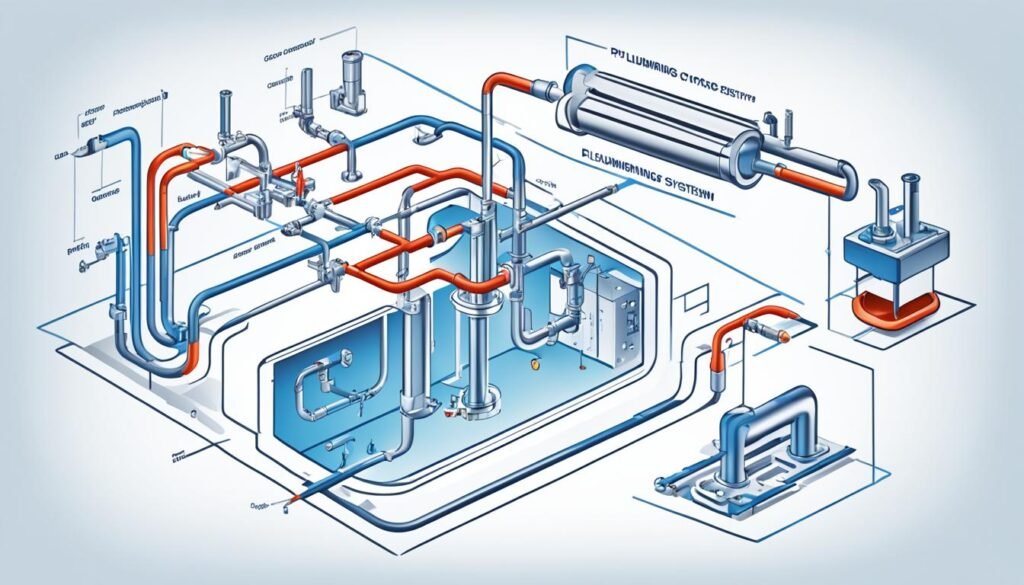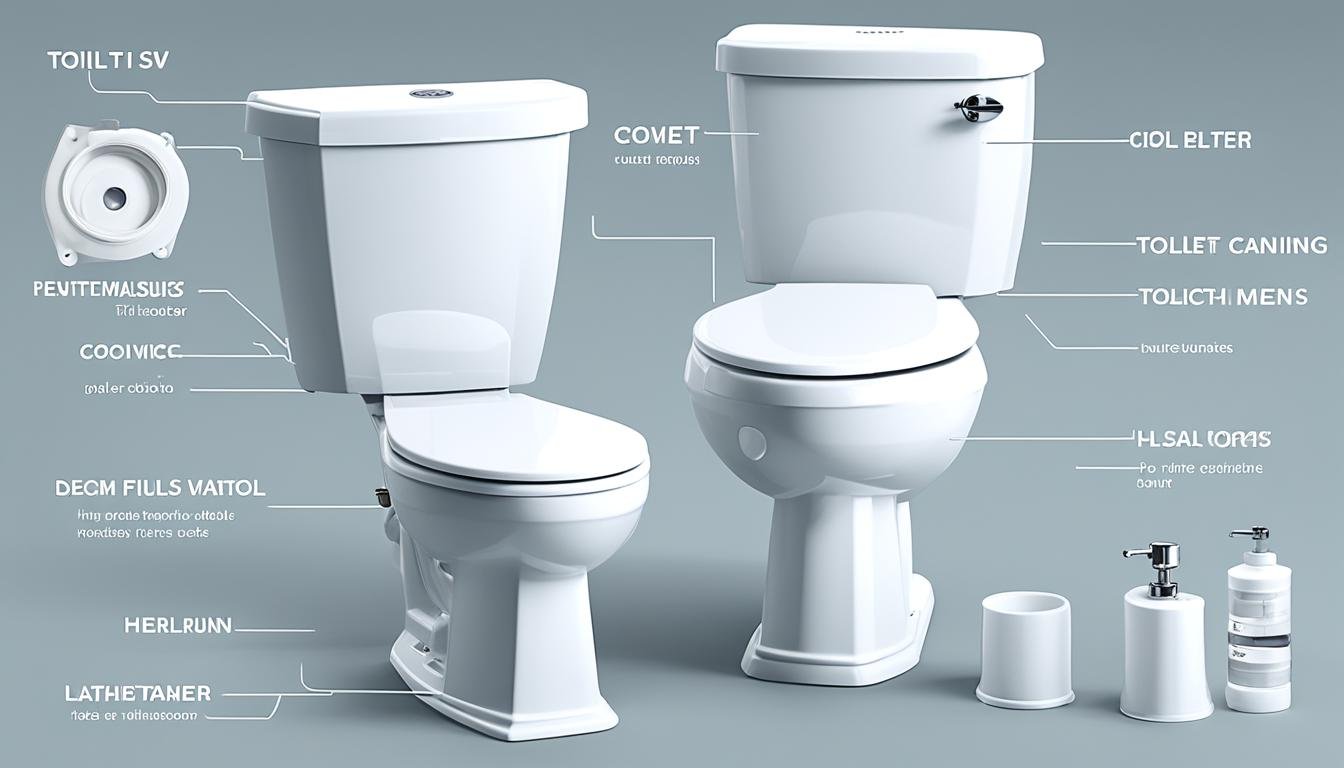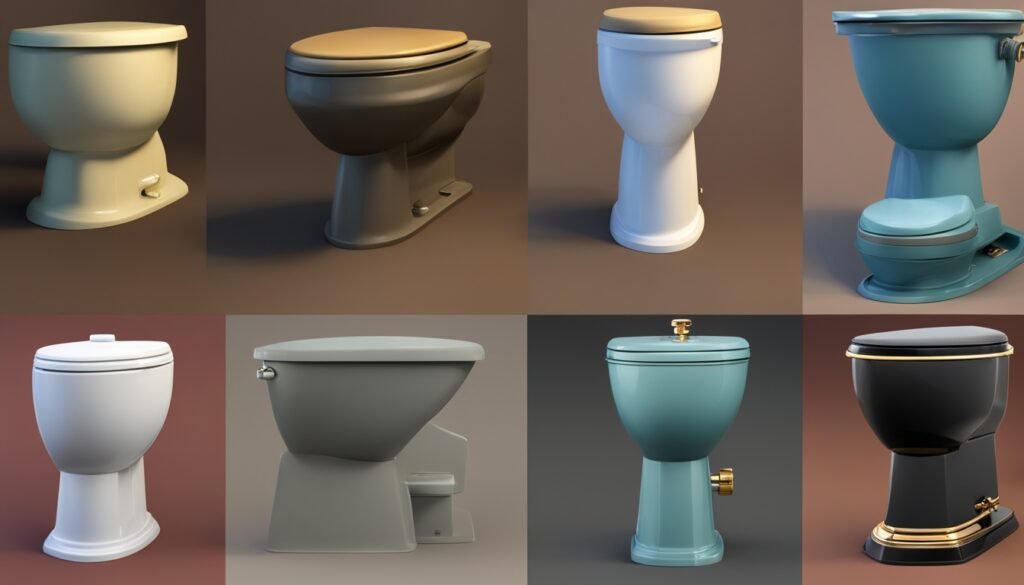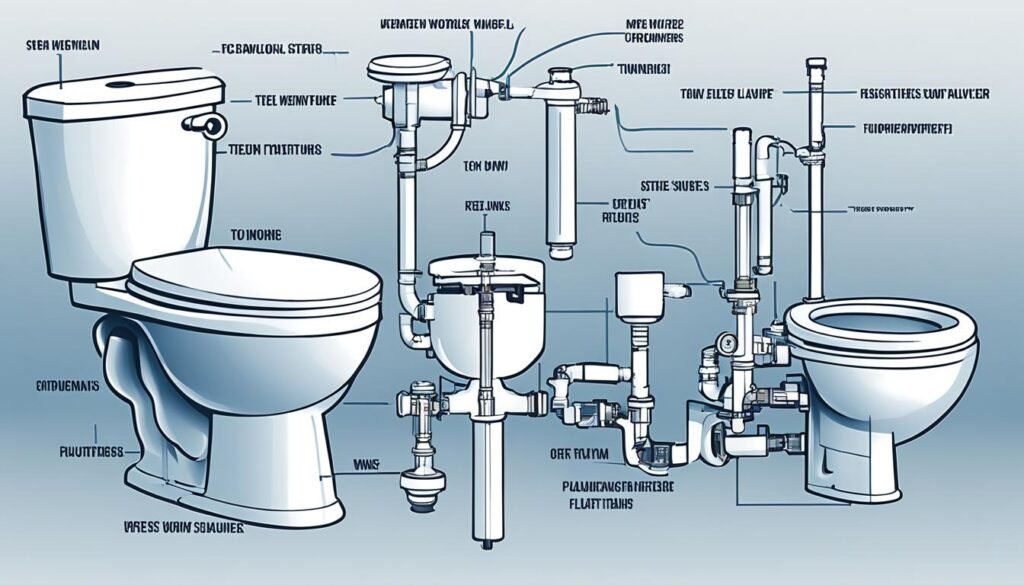Did you know that plumbing leaks waste about 1 trillion gallons of water every year in the US? This is the same as 40 million swimming pools. It’s important to know about your home’s plumbing. This can stop costly water damage and keep water flowing well.
Your house has a network of pipes to carry water in, around, and out of your house. The first type of pipes are the water supply pipes. They are where fresh drinking water comes into your house. After that, there’s a system of pipes that takes the water to sinks and showers. These are the distribution system. It uses smaller pipes to connect major lines to your fixtures. Then, drainpipes are used to take away dirty water from your sinks and showers. This is how the core plumbing system in a house works.
Key Takeaways
- Plumbing systems have two main parts: water supply pipes and the drain-waste-vent (DWV) system.
- Water supply pipes bring fresh drinking water into the home. The distribution system sends it to sinks and showers.
- Drainpipes carry away dirty water. They work with the DWV system to make sure water drains properly.
- Plumbing leaks can use a lot of water, so it’s key to know and keep up your plumbing system.
- Regular checks and fixes for your plumbing are important. They help avoid big water damage and keep things running well.
Understanding the Water Supply System
The water supply system is crucial for every home, providing clean, pressurized water. It revolves around the water service lines. These are underground pipes linking your home to the main water source.
Water Service Lines and Main Shutoff Valve
Copper, cast iron, galvanized steel, and PVC are used for water service lines. Indoor plumbing often uses copper. Schedule sizes (40, 80, 120) show the pipe diameter. For cheaper outdoor options, consider PVC.
The main shutoff valve lets you turn off all water in your home. It’s key for emergencies like leaks. Knowing and keeping it maintained can prevent water damage.
Good water pressure is vital for your plumbing. Issues like leaks and mineral buildup can reduce pressure. Regular checks and fixes keep your water system running well.
| Plumbing Material | Key Features |
|---|---|
| Copper Tubing | Corrosion-resistant, durable, and able to withstand high pressure and temperature extremes. |
| PVC Pipes | Affordable, easy to install, resistant to blockages, and flexible enough to tolerate high water pressure. |
| Galvanized Steel Pipes | Prone to rust development, which can contaminate water, making them unsuitable for human consumption. |
| PEX Pipes | Durable plastic construction, rigid yet flexible, and can be easily navigated through walls, ceilings, and basements without the need for soldering. |
Having a well-maintained water supply system is key for your home’s safety. Understand the basic parts and upkeep practices to enjoy clean, reliable water. If you need help with your system, visit plumbersinhemetca.com or look at Dream Home Digest for more advice.

Core Components of Plumbing System
Your home’s plumbing system has many important parts. These work together to bring clean water in and take waste out. Knowing about these pieces helps you keep your plumbing in good shape and fix problems when needed.
The drain, waste, and vent (DWV) system is vital. It includes drain pipes, drain traps, and drain vents. Drain pipes use gravity to move dirty water from places like sinks and toilets into the sewer. Drain traps stop bad smells from coming up by trapping water. Drain vents let air into the plumbing to keep water flowing smoothly and prevent odd noises.
Plumbing fixtures include sinks, toilets, and bathtubs. They join the water and waste systems, letting water in and waste out. These units are made of different materials, like porcelain and stainless steel, to match your style and budget.
The water heater is also key. It provides hot water for showering and doing dishes. There are tank-style and tankless water heaters, each serving a important at different household tasks.
You can also add water treatment systems to your plumbing. These systems clean the water by removing harmful substances. They range from whole-house filters to specific treatments for water issues like hard water or lead.
Knowing about your plumbing system lets you understand how important it is for a comfy home. Keeping it well-maintained is crucial. This ensures it works well and lasts long.

For more plumbing tips, visit Plumbers in Hemet, CA, or see Dream Home Digest for expert advice.
Exploring the Drain-Waste-Vent (DWV) System
The DWV system is key to your home’s plumbing. It includes drain pipes, traps, and vents. It works by moving wastewater out and keeping air balance right.
Drain pipes are core to the DWV. They let gravity take used water from your home to the sewer. It’s important these pipes are the right size and installed well. They can get blocked by things like hair and grease.
To stop bad smells from sewers, there are drain traps. These traps have water in them to block gases. It’s vital to keep these traps clean for a healthy home.
Drain vents are the last part. They add air to the system, helping water move without issues. If these vents aren’t working right, you might notice slow drains or smell bad odors.
The DWV system does a lot for your house. Keeping it well-maintained is critical. Clean out traps and fix clogs early. Always call a pro if you need help to make sure your plumbing stays safe and efficient.
| Component | Function | Common Issues |
|---|---|---|
| Drain Pipes | Carry wastewater from fixtures to sewer line using gravity | Clogging due to hair, grease, and debris buildup |
| Drain Traps (P-traps) | Hold water to prevent sewer gases from entering the home | Dried or cracked traps, blockages |
| Drain Vents | Release air into the system to ensure smooth drainage | Blockages, cracks or leaks, improper installation |
“Proper maintenance of the DWV system is crucial for the overall health and efficiency of your home’s plumbing infrastructure. Ignoring issues with drain pipes, traps, or vents can lead to serious problems down the line.”
– Excerpt fromDream Home Digest
Conclusion
It’s vital to know about a home’s plumbing system. This includes the water supply and the DWV systems. Keeping these in good shape makes your home work smoothly.
Regular checks, like looking for leaks and cleaning traps help. It also pays to insulate your pipes. This care can stop big repair bills later on.
When you spot low water pressure or slow drains, don’t wait. Get a professional plumber to help. Check out the plumbers suggested by Dream Home Digest. They know their stuff and can solve your problem quickly.
The history of plumbing shows how much it matters. From ancient sewer pipes to today’s safe materials, it’s key for our health. The term “plumber” even comes from an old Roman word.
Today’s plumbing uses better materials. This makes our systems strong and reliable. Making sure your plumbing is well-maintained is crucial for any homeowner or professional. It keeps everything running well and avoids big problems.
Working with skilled plumbers is a smart move. Find the best ones, like those you can locate on //plumbersinhemetca.com/. This ensures your home is both comfy and safe.
FAQ
What are the two core components of a plumbing system?
In a house, plumbing has two key parts. First, the water supply system. Second, the drain-waste-vent system known as DWV.
What are the main parts of the water supply system?
The water supply system has water service lines and main shutoff valves. It also has a network of copper or plastic tubes. These tubes connect sinks, showers, and other fixtures to the main water source.
How does the drain-waste-vent (DWV) system work?
The DWV system moves water away using pipes, traps, and vents. Gravity helps wastewater flow out. Traps stop smells from coming back in. Vents let air in for easier draining.
What are some common issues with the DWV system?
Largely, the DWV’s pain points are clogs and hidden leaks. Clogs form from hair, grease, and debris. Leaks hidden in walls or ceilings can cause mold, stains, and smells.
How can I maintain my home’s plumbing system?
To keep your plumbing in shape, check for leaks and clean traps. Insulating your pipes is also vital. If you spot issues, contact a local pro, like the ones at Dream Home Digest.
Source Links
- https://www.bobhoeglerplumbing.com/blog/2023/02/17/key-components-of-residential-plumbing/
- https://happyhiller.com/blog/understanding-the-basics-of-plumbing/
- https://www.bestaccessdoors.com/blog/plumbing-101-what-are-the-different-parts-of-a-plumbing-system/
- https://pathmakerplumbing.com/what-are-the-main-components-of-a-home-plumbing-system/
- https://nexgenairandheat.com/a-guide-to-plumbing-system-types-components-and-fixtures/
- https://www.jimmyjoesplumbing.com/blog/2024/5/1/understanding-the-basics-home-plumbing-systems-explained-T4wRk
- https://www.tubomart.com/the-basics-of-plumbing-understanding-the-components-of-a-plumbing-system/
- https://pugetsoundplumbing.com/3-main-components-of-a-plumbing-system/
- https://trdsf.com/blogs/news/plumbing-installation-guide
- https://intownplumbingtx.com/articles/home-plumbing-system-guide/
- https://www.linkedin.com/pulse/drain-waste-vent-dwv-system-market-exploring-share-trends-ktrcc?trackingId=+2JV94YAX7oUhcqo4KzG/A==
- https://www.mdsewer.com/plumbing/plumbing-vent-pipe
- https://en.wikipedia.org/wiki/Plumbing
- https://www.britannica.com/technology/plumbing
- https://theconstructor.org/environmental-engg/water-supply/major-types-valves-plumbing-system/552487/




